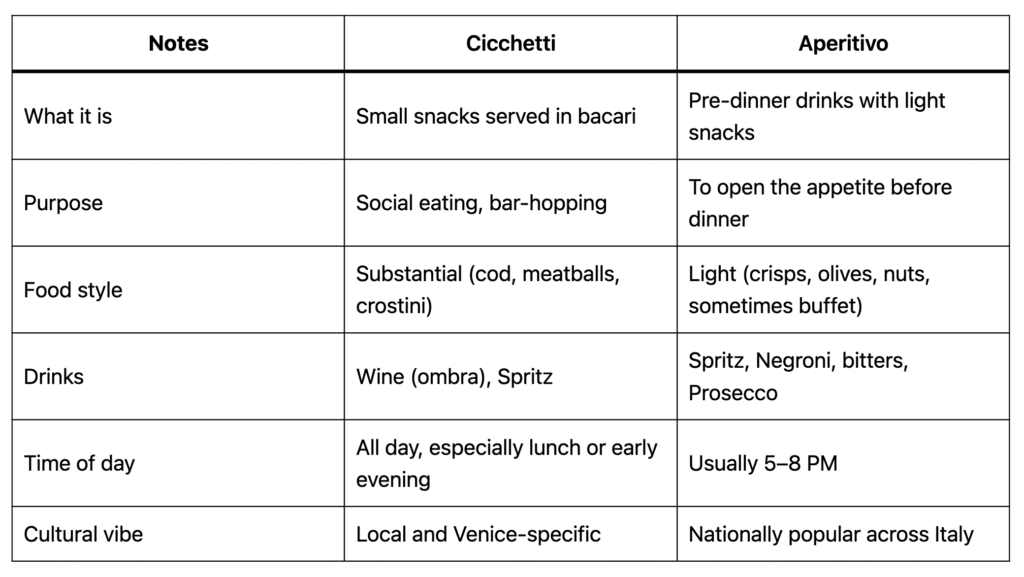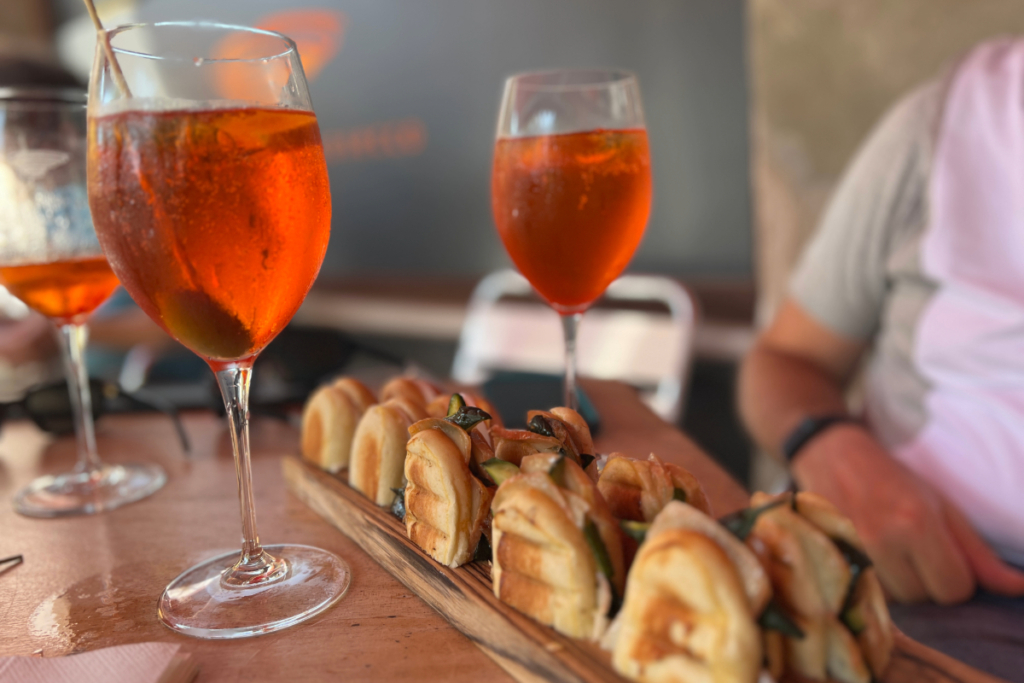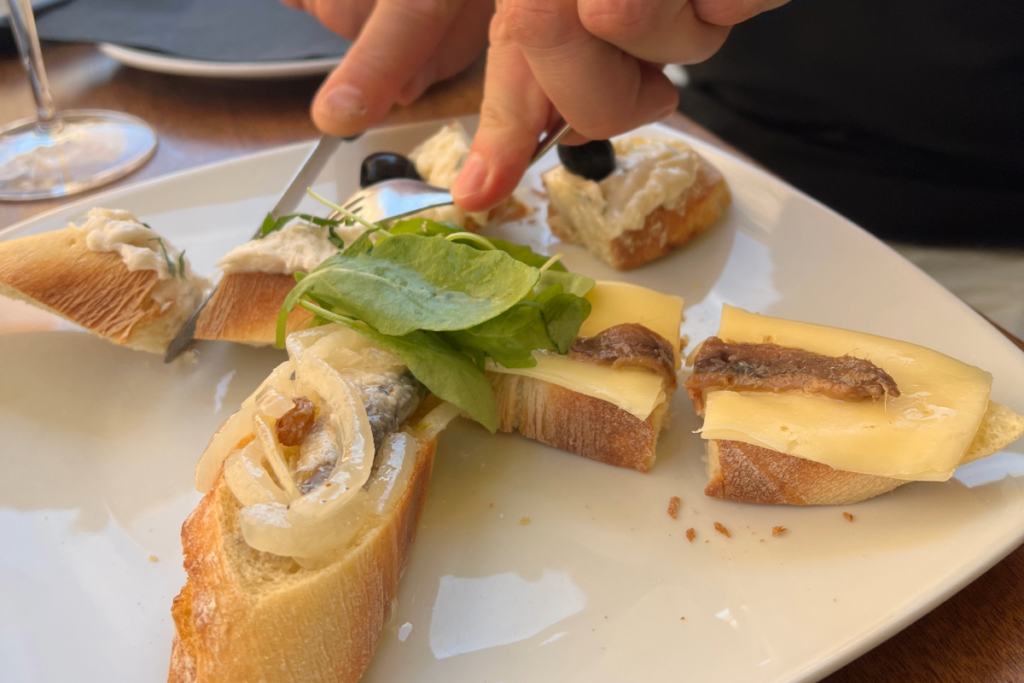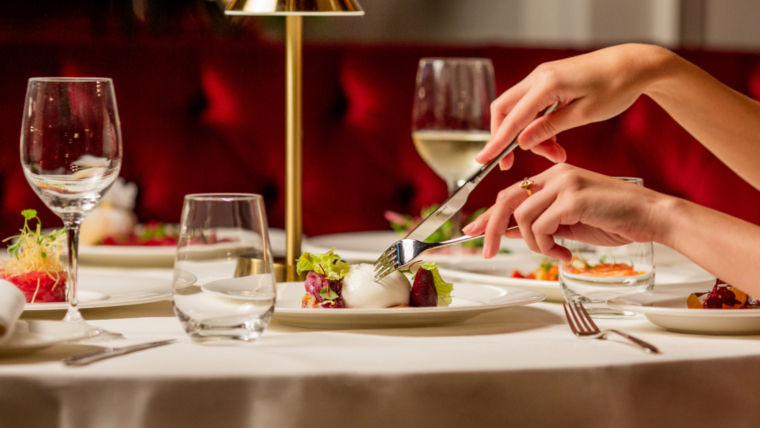If you’re in Venice and not diving into cicchetti, you’re honestly missing the real heart of the city. Forget the tourist traps and overpriced menus. The true Venetian food scene happens standing up, with a small glass of wine in hand and a plate of mouthwatering little bites.
Cicchetti (pronounced chee-KEH-tee) are basically Venice’s version of tapas; small, savoury bites usually served in cosy little bars called bacari. You’ll see them lined up behind glass counters: bite-sized bits of seafood, cured meats, creamy spreads on crusty bread, and the kind of perfectly fried things you can never have just one of.
But it’s not just about the food, it’s also about how you eat it. Venetians don’t sit down for this. They crowd around the bar, drink in hand, chatting and grazing, standing shoulder-to-shoulder like it’s the most natural thing in the world. And honestly, it is.
That’s the beauty of cicchetti. They’re quick, affordable, and everywhere. But somehow still feel special. Each one tells a little story of the city: its trading past, its love of simplicity, and the way locals just get how to enjoy life without making a fuss.
The Culture Behind Cicchetti
Cicchetti actually come from Venice’s trading days. Way back when, the city was buzzing with merchants, dockworkers, and sailors. Full sit-down meals weren’t always an option, especially if you were on the move or working long hours. So instead, people grabbed quick, tasty bites and washed them down with an ombra — a small glass of local wine. It was simple, filling, and easy to enjoy standing up.
The bars that served them, known as bacari, were never fancy. And they still aren’t. They’re no-frills, tucked-away places where locals stop in for a breather, a drink, and a chat. That same down-to-earth energy is still there. Whether you pop in for a quick bite or turn it into a proper cicchetti crawl, you’re getting a real slice of Venice — the everyday, working-class kind that tourists often miss.
It’s not just food. It’s how the city moves.
Classic Cicchetti You Must Try
Don’t worry about memorising menus. Just step up to the bar, take a look, and point. If you want to know what’s worth trying, start with these essentials:
- Baccalà mantecato – Creamy whipped cod spread, traditionally served on grilled polenta or toasted bread. Subtle, rich, and very Venetian.
- Sarde in saor – Sardines marinated in sweet-and-sour onions with pine nuts and raisins. A centuries-old recipe that’s tangy, savoury, and completely local.
- Polpette – Fried meatballs, often made with beef, tuna, or vegetables. Crispy outside, tender inside.
- Mozzarella in carrozza – A mozzarella sandwich, deep-fried until golden and gooey. Comfort food at its finest.
- Crostoni – Thick slices of toast topped with ingredients like gorgonzola and walnut, mortadella with pistachio cream, or seasonal vegetables.
- Marinated seafood – Think anchovies with butter, octopus salad, grilled cuttlefish. Simple, fresh, and full of flavour.
Where to Eat Cicchetti In Venice
Cantina Do Spade
Near the Rialto Market
One of Venice’s oldest bacari, dating back to the 15th century. Small, noisy, and always packed. Try the baccalà mantecato and calamari. Casanova was said to be a regular.
All’Arco
Steps from the Rialto Bridge
Run by a father-and-son team, this tiny bar is known for inventive cicchetti like tuna with horseradish and speck with truffle cream. Go early — it fills up fast.
Osteria Al Squero
In Dorsoduro, by the gondola workshop
Canal-side and full of character. Great wine, generous cicchetti, and a unique view of gondolas being repaired across the water. A local and student favourite.
Cantinone Già Schiavi
Also in Dorsoduro
Still open and thriving. Known for inventive toppings, €1.50 cicchetti, and a brilliant wine selection. Don’t miss the mortadella with pistachio or gorgonzola cheese with walnut.
Bacareto da Lele
Near Piazzale Roma
Basic, busy, and beloved. Grab a mini sandwich, sip wine from a plastic cup, and enjoy the buzz of locals and students. Super affordable and properly authentic.
How to Eat Cicchetti Like a Venetian
- Order just a few at a time. Eat, then decide if you want more.
- Drink an ombra or try a traditional Spritz al Select, the more herbal, slightly bitter cousin of Aperol.
- Stand, eat, and talk. Bacari are designed for movement, not lingering at a table.
- Try a few places in one outing. That’s part of the experience.
Cicchetti vs Aperitivo: What’s the Difference?
While cicchetti and aperitivo both mix food and drink in a casual setting, they’re not the same. Understanding the difference will help you eat like a local and make the most of Venice’s unique food culture.

Read more: Aperitivo Italy’s Pre-Dinner Obsession
Smart Tips for Your Cicchetti Crawl

Budget
Expect to spend around €1.50 to €3.00 per cicchetto and €1.50 to €4.00 per drink. With a few stops and several bites, a full-on cicchetti crawl usually comes in between €10 and €20 per person. Compared to a sit-down meal in Venice, especially near the tourist hotspots, this is an incredibly affordable way to eat well — and with far more variety and character.
When to eat Cicchetti
The best windows are late morning (around 11 am to 1 pm) and early evening (5 pm to 8 pm). These are the times locals naturally gather for a quick bite and drink, and when the bacari feel most alive. In the late morning, you’ll often catch market workers and locals on their break; in the evening, the mood shifts to post-work socialising, with more crowds and energy.

How to order cicchetti
Most bacari don’t have menus. Instead, the cicchetti are displayed behind glass at the bar. Just look, point, and say, “Uno di questo, per favore” (One of these, please). Staff are used to travellers and usually very patient — a smile and a bit of politeness go a long way. If something’s unclear, don’t be afraid to ask what it is; they’ll either explain or let you try
How to find a bacari
Use Google Maps to locate the better-known bacari, but keep your eyes open. Some of the best places are tucked away down side streets or canals, and you won’t always spot them until you’re right in front of one. Wandering is part of the fun — Venice rewards curiosity. If a place is packed with locals and the food looks good, you’ve probably found a winner.
Etiquette
Bacari are small, lively, and not built for lingering. Expect to stand, often shoulder-to-shoulder with strangers. Sharing space is normal and encouraged. Be aware of your surroundings, especially if you’re in a group — don’t crowd the counter too long, and make room for others. Eat, drink, chat, then move on. That’s the unwritten rhythm of cicchetti culture.
That Said

Can you make a full meal out of cicchetti?
Yes — and it’s one of the most enjoyable ways to eat in Venice. Many locals treat cicchetti as a full lunch or dinner, especially when they’re on the go or meeting friends. A typical “meal” might involve stopping at two or three bacari, trying a few bites at each, and sipping wine or a spritz along the way. It’s casual, flexible, and lets you taste more of what the city has to offer. Instead of committing to one long sitting, you move with the rhythm of the city, sampling flavours, soaking up atmosphere, and engaging with locals.
Is Cicchetti Expensive?
Not at all. Cicchetti are one of the most budget-friendly ways to eat well in Venice. Most bites cost between €1.50 and €3.00, and you can easily enjoy a satisfying spread for under €15. Bacari often serve house wine (ombra) starting at around €1.50 per glass, so you won’t need to splurge to eat something fresh, local, and delicious. Compared to sit-down meals, especially in tourist-heavy areas, cicchetti give you better value and a more authentic experience.
Do bacari have seating?
Usually, no — and that’s part of the charm. Most bacari are small, standing-room-only spots with narrow counters, where you eat elbow-to-elbow with locals. Some might have a bench or a ledge outside, and in good weather, people often sit along the canal with their plates and glasses. This standing format isn’t just tradition; it encourages quick turnover, spontaneous conversation, and hopping from place to place, which is the essence of cicchetti culture.
What is an Ombra?
An ombra is a small glass of local house wine, typically served in bacari alongside cicchetti. The word literally means “shade” in Italian and dates back to when wine vendors would follow the shadow of the bell tower in St Mark’s Square to keep their wine cool. Today, ordering an ombra is a way to drink like a Venetian — no fuss, no fancy stemware, just a well-priced pour of white, red, or even sparkling wine that pairs perfectly with whatever’s on your plate
Are cicchetti just for tourists?
Absolutely not. Cicchetti are a vital part of Venetian daily life. Locals of all ages eat them — from university students grabbing a snack on the way home, to shopkeepers on their lunch break, to friends meeting for a quick pre-dinner drink. While tourists have caught on to the charm, the culture remains rooted in the habits of everyday Venetians. If anything, joining the cicchetti scene is one of the most respectful and immersive ways you can experience the city like a local.



